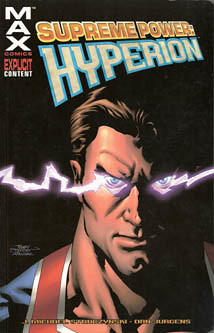Supreme Power: Hyperion
Collects: Supreme Power: Hyperion #1-5 (2005-6)
Released: June 2006 (Marvel)
Format: 120 pages / color / $14.99 / ISBN: 9780785118954
What is this?: Following the end of the first volume of the Supreme Power reboot, the Army sends four superhuman operatives to confront Hyperion (a Superman analogue) and return him to the fold.
The culprits: Writer J. Michael Straczynski and artist Dan Jurgens.
Marvel has made the mistake of allowing several series to lose their momentum: Young Avengers is the most egregious example, although many readers would point out the examples of Nyx and Supreme Power should not be forgotten.
But looking over the publication history for the Supreme Power universe, there haven’t been as many lulls as I had thought. Writer J. Michael Straczynski revamped some old Marvel characters who started as obvious analogues for major DC characters. V. 1 started in August 2003 and ran until August 2005 — two years for eighteen issues, which doesn’t set the world on fire, but it isn’t embarrassing either. Then came a series of miniseries written by Straczynski and others, mixed in with a abortive, seven-issue v. 2. None of this seems to inspire confidence in the line as a hole — especially not Ultimate Power, the Squadron Supreme’s crossover with the Ultimate line, a line that is itself floundering its way to radical change. The latest try, Squadron Supreme, has just dropped beneath 20,000 in sales, according to Paul O’Brien’s calculations.
 So let’s consider a book somewhere early — or perhaps even before — the slide began. Supreme Power: Hyperion was released the month after v. 1 of Power ended, at the same time as Supreme Power: Nighthawk. Unlike Nighthawk, Hyperion featured Straczynski as writer and had the series’ central character — Hyperion, a Superman analogue — as its star.
So let’s consider a book somewhere early — or perhaps even before — the slide began. Supreme Power: Hyperion was released the month after v. 1 of Power ended, at the same time as Supreme Power: Nighthawk. Unlike Nighthawk, Hyperion featured Straczynski as writer and had the series’ central character — Hyperion, a Superman analogue — as its star.
Hyperion reads like it’s another five issues of the regular series. It doesn’t feel like a Hyperion series at all, since it follows a group of governmental agents as they track down the rogue Hyperion to return him to the fold. The book focuses on the seed of Squadron Supreme, then — here might have been the time to go to the Squadron Supreme name. The agents featured — Arcanna, Emil Burbank, Shape, and Nuke — are almost interesting enough to carry the book, but they have to share time with Hyperion, who’s a big black hole of boredom; whenever the book veers near him, excitement slows, then is unable to escape from the page.
The plot deals with alternate timelines / futures; the team just wants to return to our world, while Hyperion is indoctrinated into power by his alternate self. That Hyperion isn’t interesting either, just a low-key controlling evil that just decided, hey, it’s for the best if I’m in charge. Maybe it is. I can’t tell, and I don’t particularly want to debate the point. Certainly not with someone who has heat vision.
Probably it isn’t, though, because Straczynski shows alternate Hyperion using the behavior modification machine from the original Squadron Supreme miniseries back in the ‘80s. The B-mod machine reprograms the brain however the user wants, and presumably it’s used to change the minds of the legion of superheroes who now support Hyperion. (We don’t see that, but it’s a reasonable guess.) I like the nod to previous stories, but the machine’s potential isn’t fully used here. Since I’m not terribly wild about the plot — Hyperion seems more interesting quips and quirks than an interesting story — I feel it could have been explored more. (Of course, it’s a mind-control machine. Perhaps there’s nothing else to explore?)
I’m not fond of Dan Jurgens’s art; it’s a little too reminiscent of John Romita, Jr., and late Sal Buscema for my taste. Still, that doesn’t mean it isn’t good, just that I don’t like it. The storytelling is competent, although not adventurous; his designs of previously unseen Squadron members are conservative at best. I will give him points for resisting fishnets for Skylark and Arcanna Jones, who are analogues of Black Canary and Zatanna, respectively.
The book feels like all middle — like The Empire Strikes Back, except without the rampant coolness. Obviously, Straczynski had plans for the Supreme Power universe. Now he won’t get to realize them. (Why would he want to, after the universe has been sullied by the Ultimate universe?) This is but one step in a journey leading not to a conclusion but a cliff, and the journey itself isn’t that enjoyable.
Rating: ![]()
![]() (2 of 5)
(2 of 5)
Labels: 2, Dan Jurgens, Hyperion, J. Michael Straczynski, Marvel, Squadron Supreme, Supreme Power




0 Comments:
Post a Comment
<< Home